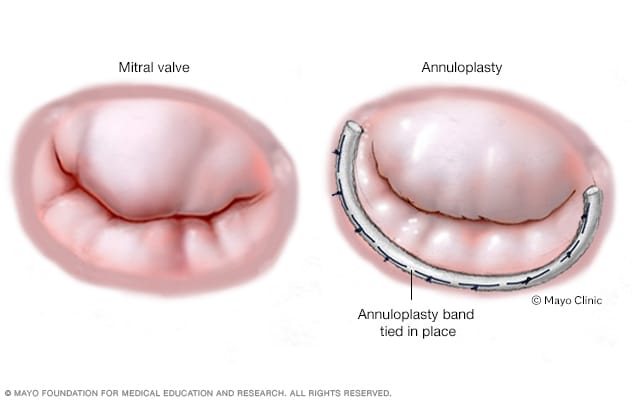-
Cardiovascular
Mitral valve repair and mitral valve replacement

Mitral valve repair and mitral valve replacement are procedures that may be performed to treat diseases of the mitral valve — the valve located between the left heart chambers (left atrium and left ventricle).
Several types of mitral valve disease exist. In mitral valve regurgitation, the flaps (leaflets) of the mitral valve don't close tightly, causing blood to leak backward into the left atrium. This commonly occurs due to valve leaflets bulging back — a condition called mitral valve prolapse.
In another condition, called mitral valve stenosis, the leaflets become thick or stiff, and they may fuse together. This results in a narrowed valve opening and reduced blood flow through the valve.
Treatment for mitral valve disease depends on the severity of your condition. Surgery may be recommend to repair or replace mitral valves for some people with mitral valve disease. Several surgical procedures exist to repair or replace mitral valves, including open-heart surgery or minimally invasive heart surgery.
Why it's done
Mitral valve disease treatment depends on how severe your condition is, if you're experiencing signs and symptoms, and if your condition is getting worse.
Your health care provider and treatment team may evaluate you to determine the most appropriate treatment for your condition. In an evaluation, there may be a physical examination, a review of your medical history and tests performed.
Your health care provider may first suggest monitoring your condition with regular evaluations if you're not experiencing symptoms or your condition is mild. You may be prescribed medications to manage symptoms. If your condition is mild, you may not need surgery.
However, your mitral valve may eventually need to be repaired or replaced. In some cases, health care providers may recommend mitral valve repair or mitral valve replacement even if you're not experiencing symptoms. Research has found that performing surgery in a person with severe mitral valve regurgitation who isn't experiencing symptoms, rather than monitoring the condition, can improve long-term outcomes.
If you need heart surgery for another condition in addition to mitral valve disease, doctors may conduct surgery to treat both conditions at the same time.
Your doctor will discuss with you whether mitral valve repair or mitral valve replacement may be most appropriate for your condition. Doctors often may recommend mitral valve repair. However, if mitral valve repair isn't possible, doctors may need to perform mitral valve replacement. Doctors may also evaluate whether you're a candidate for minimally invasive heart surgery or open-heart surgery.
Mitral valve repair surgery should generally be performed at a medical center with staff that has experience in performing mitral valve repair surgery and that has conducted high volumes of mitral valve repair surgeries.
Annuloplasty
An annuloplasty is a procedure to tighten or reinforce the ring around a valve in the heart. This may be performed during other procedures to repair a heart valve.
The ring around a valve in the heart (annulus) can widen and change from its normal shape. This may occur when the heart is enlarged or when blood is leaking backward through the valve. The widening of the ring can cause the valve flaps (leaflets) attached to the ring not to open and close properly, which can cause blood to leak backward through the valve.
In some people, calcium deposits can build up on the ring, which can cause the valve flaps not to work properly and lead to blood leaking backward.
To repair these issues, an annuloplasty or other valve repair procedures may be performed. An annuloplasty may be done to reshape, reinforce or tighten the ring around a heart valve (annulus).
Valvuloplasty
A valvuloplasty, also known as balloon valvuloplasty or balloon valvotomy, is a procedure to repair a heart valve that has a narrowed opening.
In this valve condition, the valve flaps (leaflets) may become thick or stiff, and they may fuse together (stenosis). This causes the valve opening to be narrowed and results in reduced blood flow through the valve.
A valvuloplasty may improve blood flow through the valve and improve your symptoms.

Doctors may evaluate you and determine if valvuloplasty or another treatment is appropriate for your valve condition.
If you have severe valve stenosis and you're experiencing symptoms, your doctor may recommend valvuloplasty. Your doctor may recommend valvuloplasty to repair a mitral valve with a narrowed opening (mitral valve stenosis) even if you don't have symptoms.
Your doctor may also recommend valvuloplasty if you have a narrowed aortic valve (aortic valve stenosis). The procedure can treat aortic valve stenosis in infants and children. However, the valve tends to narrow again in adults who've had the procedure so it's usually performed only in adults who are too ill for surgery or who are waiting for a valve replacement.
This procedure can also be performed to treat narrowed tricuspid or pulmonary valves.
Learn more about advanced technology and treatment options at Mayo Clinic.
This article is written by Mayo Clinic staff. Find more health and medical information on mayoclinic.org.








